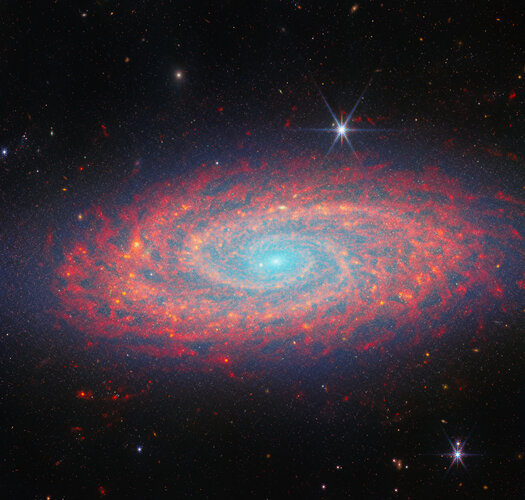Featured in this NASA/ESA/CSA James Webb Space Telescope Picture of the Month is the spiral galaxy NGC 2090, located in the constellation Columba. This combination of data from Webb’s MIRI and NIRCam instruments shows the galaxy’s two winding spiral arms and the swirling gas and dust of its disc in magnificent and unique detail.
NGC 2090 was one of many galaxies studied by the NASA/ESA Hubble Space Telescope to refine the measurement of the Universe’s expansion rate, or ‘Hubble constant’. This can be done by observing a special type of variable stars named ‘Cepheids’ in relatively nearby galaxies. The Cepheid-based measurement, conducted in 1998, determined NGC 2090 to be 37 million light-years away from Earth. In contrast, according to the newest measurements, NGC 2090 should be slightly farther away, at 40 million light-years. To this day, Hubble is surveying galaxies in visible and ultraviolet light; alongside this Webb image a new Hubble image of NGC 2090 has also been published this week.
Already before that Hubble project in 1998, NGC 2090 had been well studied as a very prominent nearby example of star formation. Described as a ‘flocculent’ spiral, this galaxy has a patchy, dusty disc and arms that are flaky or not visible at all. We can see those patterns well in Hubble's visible-light images. However, Webb’s NIRCam near-infrared data reveal the spiral arms with remarkable clarity. NIRCam also picks up bright light from stars, displayed in blue and most visible in the galaxy's centre. At the same time, Webb’s MIRI captures the mid-infrared light from the carbon-based compounds along the many strands of gas and dust. This MIRI data is pictured as red in the Webb image.
These data on NGC 2090 were collected as part of an observing programme (#3707) capturing many similar nearby massive, star-forming galaxies. These galaxies are located at just the right distance and have a good level of activity, so that Webb’s instruments can capture a detailed picture of their star-forming activity. This gives us a unique insight into the tightly-bound clusters of young stars and clouds of gas within the galaxies in which stars are born. The rich collection of detailed images like this one will be of value to astronomers studying star formation for years to come.
[Image Description: A spiral galaxy with a wide, oval-shaped disc. It has a shining spot at the centre from which two curving, pale red spiral arms emerge, wrapping once each around the galaxy. They’re surrounded by a whirl of bright threads and patches of dust, with spots of star formation scattered throughout. The glow of the disc fades smoothly into the background where some patches of dust can be seen, as well as foreground stars.]



 Image:
Webb traces spiral arms in infrared
Image:
Webb traces spiral arms in infrared